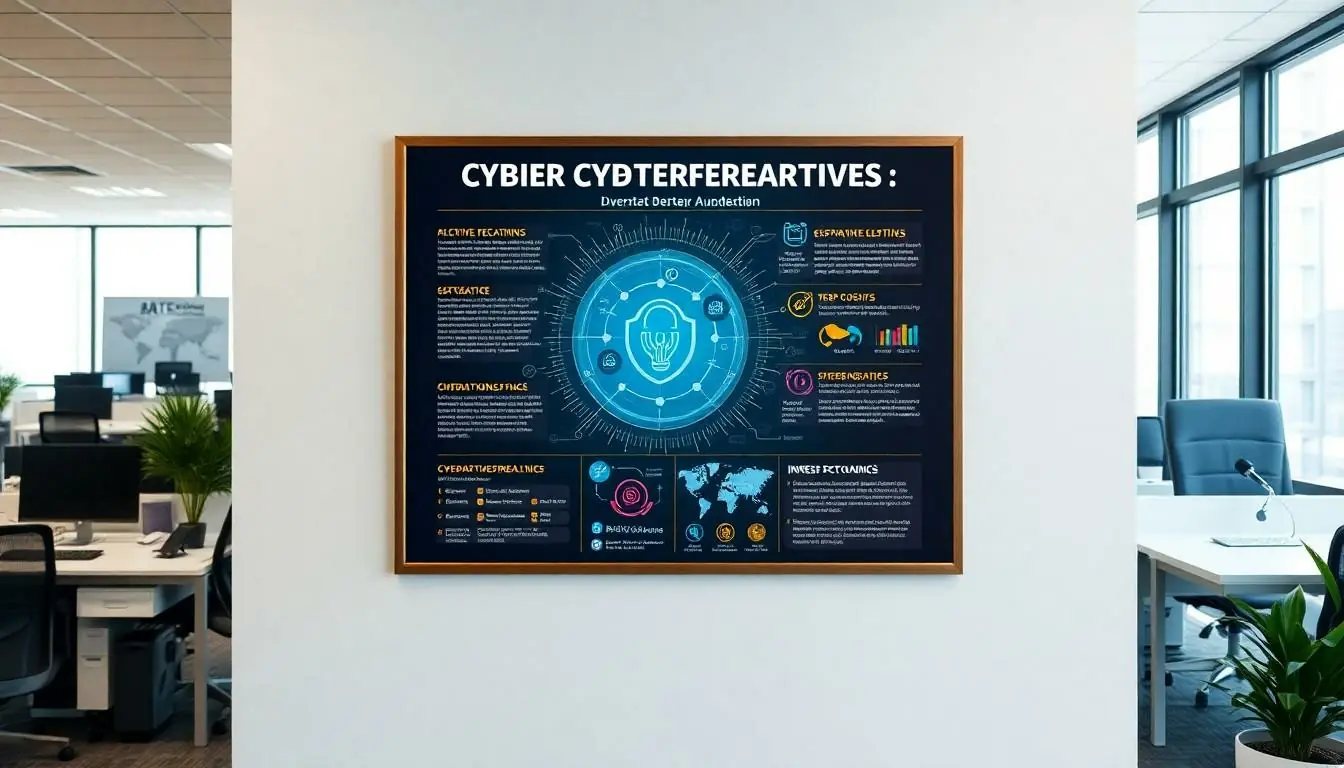In a world where cyber threats lurk around every digital corner, it’s time to turn the spotlight on cybersecurity awareness. Imagine walking into your office and being greeted by a colorful poster that not only catches the eye but also educates the mind. These posters aren’t just pretty decorations; they’re your first line of defense against the sneaky hackers trying to steal your lunch—or worse, your personal data!
Cybersecurity awareness posters serve as friendly reminders that staying safe online doesn’t have to be boring. With clever graphics and witty slogans, they transform crucial information into memorable nuggets of wisdom. So why not spruce up those dull walls and equip everyone with the knowledge to fend off cyber villains? After all, a little humor goes a long way in making serious topics like cybersecurity approachable and engaging.
Table of Contents
ToggleImportance Of Cybersecurity Awareness Posters
Cybersecurity awareness posters play a vital role in educating individuals about digital threats. Engaging visuals attract attention and simplify complex topics, fostering a better understanding of cybersecurity.
Enhancing Understanding Of Threats
Posters provide clear examples of various cyber threats, including phishing, malware, and social engineering. Representation of these threats in visual formats helps individuals easily recognize potential dangers. They break down intricate concepts into simple, relatable categories, improving overall comprehension. Displaying statistics alongside imagery can reinforce the reality of these threats. Regular exposure to these visual reminders keeps cybersecurity at the forefront of employees’ minds. In summary, posters effectively demystify cybersecurity by transforming technical details into easily digestible information.
Encouraging Safe Practices
Effective posters promote best practices for safe online behavior. Key messages, like creating strong passwords and recognizing suspicious emails, are emphasized visually. Furthermore, they remind individuals of the importance of regular software updates and secure browsing habits. Through vibrant graphics, these posters encourage proactive measures, fostering a culture of security-consciousness. By instilling these practices, organizations can significantly reduce the likelihood of successful cyber attacks. Leveraging humor or relevant graphics makes the message more memorable, allowing safe practices to resonate across the workplace.
Key Elements Of An Effective Poster

Effective posters convey crucial information at a glance, ensuring individuals grasp key cybersecurity concepts quickly. Each element plays a significant role in fostering awareness.
Clear Messaging
Messaging must be straightforward and concise. Distilling complex ideas into brief phrases allows individuals to understand them easily. Using active voice enhances clarity, prompting action or thought. For example, “Recognize phishing attempts” clearly communicates what individuals should do. Ensure key warnings and tips are prominently displayed to capture attention. Utilizing bullet points can also help break down information, presenting it in digestible segments. Individuals retain information better when it is clearly stated, so focus on the essentials of cybersecurity best practices.
Visual Appeal
Visuals greatly enhance a poster’s effectiveness. High-quality images and graphics draw attention and illustrate concepts effectively. Colorful designs can stimulate interest, making posters stand out in a workspace. Incorporating relatable infographics simplifies complex information, enhancing understanding. For instance, pie charts or bar graphs can visually represent statistics about cyber threats. Typography matters too; selecting legible fonts in appropriate sizes ensures readability. Creative layouts guide viewers’ eyes, emphasizing important messages while maintaining visual harmony. Engaging visuals alongside concise text create a well-rounded approach to cybersecurity awareness.
Types Of Cybersecurity Awareness Posters
Cybersecurity awareness posters come in various formats, each serving a unique purpose to enhance understanding and engagement. The primary types include informational and motivational posters.
Informational Posters
Informational posters focus on educating individuals about specific cybersecurity threats and practices. They often use concise text to explain concepts like phishing, malware, and social engineering. Relevant statistics help illustrate the prevalence of these threats, making the information more impactful. Visual elements, such as infographics and icons, assist in clarifying complex ideas. Key takeaways are presented in a straightforward manner, ensuring quick comprehension. Informational posters ensure employees recognize potential dangers at a glance, reinforcing the importance of staying vigilant.
Motivational Posters
Motivational posters aim to inspire proactive cybersecurity behavior among employees. They feature catchy phrases that encourage safe online practices, like creating strong passwords and reporting suspicious emails. Visual elements often include bold graphics and engaging designs to capture attention. Emphasizing a culture of security, these posters remind individuals of their role in protecting sensitive information. Messages are crafted to foster a sense of responsibility and teamwork, creating a proactive approach to cybersecurity. Motivational posters contribute to an overall atmosphere of awareness, supporting ongoing education within the organization.
Best Practices For Distribution
Effective distribution of cybersecurity awareness posters maximizes their impact on the audience. Tailoring content and placement to engage viewers enhances overall effectiveness.
Target Audience Considerations
Understanding the target audience shapes poster content and messaging. Different departments may focus on unique aspects of cybersecurity. For example, IT staff might benefit more from technical explanations, while general employees require simplified language. Businesses should consider age, background, and experience levels when designing posters. This approach identifies the primary threats that different groups face, allowing for customized information that resonates with each audience segment.
Placement Strategies
Strategic placement of posters increases visibility and encourages engagement. Offices should display posters in common areas, such as break rooms and near printers, where employees frequently gather. Ensuring high traffic locations maximizes exposure. Additionally, placing posters on bulletin boards and alongside workstations sustains awareness throughout the day. Organizations can also rotate posters regularly, keeping content fresh and relevant, thereby rekindling interest in cybersecurity topics. Using a mix of digital displays and physical posters can enhance outreach, reaching varied audiences effectively.
Cybersecurity awareness posters are essential tools for fostering a culture of security within organizations. Their vibrant designs and clear messaging not only educate employees about potential threats but also encourage proactive behaviors. By simplifying complex concepts and providing relatable visuals, these posters make cybersecurity approachable for everyone.
Strategic placement and tailored content ensure maximum engagement, reinforcing the importance of vigilance in today’s digital landscape. As organizations continue to face evolving cyber threats, utilizing effective posters can significantly enhance awareness and understanding, ultimately leading to a more secure workplace. Investing in these resources is a smart move toward safeguarding sensitive information and promoting a collective sense of responsibility among employees.

